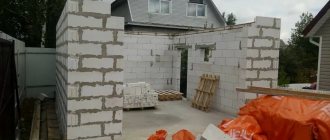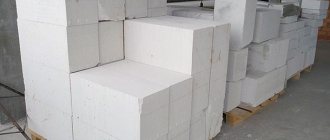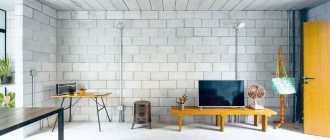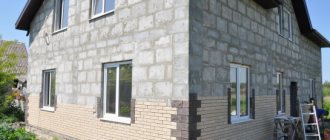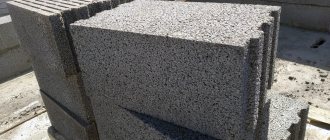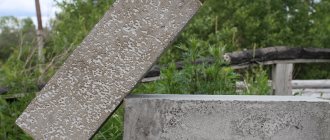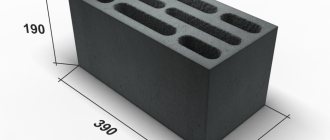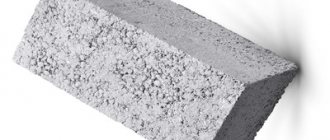At construction sites, masonry building materials for the construction of houses and the construction of partitions are presented in a wide range. Let's consider an option such as aerated concrete blocks, the pros and cons of porous concrete. Let's get acquainted with production technologies, technical characteristics, dimensions, and figure out how to determine the weight of the blocks. After reading the article, communicating with suppliers and workers will be much easier.
Aerated concrete garage Source m-strana.ru
Production of building material
To understand what aerated concrete blocks are, their advantages and disadvantages, you need to find out its composition. The basis for the production of aerated concrete is a mixture of cement, quartz, and aluminum powder. To adjust certain characteristics of the finished product, additional additives or substitutes for solid filler (gypsum, lime, ash, slag) can be used.
The binding component (M400, M500) provides a strong bond of fine-grained filler. Sand with a fraction of up to 2 mm can be mined anywhere, but it must first be cleaned of clay and biological inclusions.
Metal in the form of powder (PAP-1, PAP-2), paste or suspension is added to obtain a porous block structure. This result is achieved due to the chemical reaction of aluminum with alkali, the products of which are calcium salts and hydrogen gas.
Aluminum powder Source chellak-servis.ru
The thinner is pure industrial water. The dependence of the behavior of the solution on the temperature of the liquid medium was revealed. Therefore, the indicator is brought to at least +45℃. This approach has a positive effect on the strength characteristics and helps accelerate the hardening process of porous concrete. The possibility of reducing the portion of cement in the composition due to the increased chemical activity of the components is also noted.
The production of aerated concrete is regulated by strictly prescribed standards in the following documents:
- GOST 23732-79 (about water for preparing solutions);
- GOST 10178-85 (about cement binder).
To obtain blocks with a volume of one cube, you will need approximately 90 kg of Portland cement, 35 kg of lime, 375 kg of sand. After mixing the composition in dry form, add 0.5 kg of aluminum powder. Almost 300 liters of water are poured into a homogeneous mixture. These are standardized proportions, but each manufacturer develops its own recipe and specifications.
The pros and cons of aerated concrete in construction are determined not only by the composition, but also by the technology for manufacturing the blocks. There are two types of materials available for sale. The classification is carried out according to the type of production: with the participation of an autoclave or without an oven.
Autoclave oven Source znaybeton.ru
The process in the first stages is identical:
- the mixture and solution are prepared;
- the mass is poured into the mold (filling is 50%);
- 4-6 hours are allotted for the formation of pores;
- remove excess, cut workpieces;
- It takes up to 18 hours for the blocks to harden.
Without using an autoclave, the material must gain tempering strength, which takes 2-3 days. The products are then sent to the warehouse for another 3 weeks. Or the blanks are placed in a sealed chamber, where a pressure of up to 12 kg/sq.cm is created, and the aerated concrete is treated with hot water steam. The result is a building material of higher quality.
Is aerated concrete block dangerous and harmful to health?
Sometimes you come across information that aerated concrete is harmful. In order to understand why and why a gas block is bad, you need to disassemble all the components of this material.
- Cement . This material is present in all types of concrete and in the form of solutions it does not pose any harm to health.
- Quartz sand . This natural material may contain some amount of radioactive substances, but its use in the production of any building material is under strict control, and the manufacturer must have safety certificates and sanitary and hygienic conclusions.
- Aluminum powder (or powder). The presence of this chemical in aerated concrete scares inexperienced people the most. Aluminum powder is responsible for the most important process - gas formation and bubble formation.
The conditions created convert this chemical into hydrogen or aluminum oxide, which does not pose a health hazard.It should also be taken into account that the percentage of this substance is only 0.06-0.1% of the total composition. A certain amount of aluminum compounds are present in various building materials, including clay and brick.
- Lime . Thanks to this substance, potassium silicate is obtained during production.
- Ash and slag . These two substances are not always present in the mixture for aerated concrete, but they are sometimes used as fillers. They may contain heavy metals (cadmium, lead), therefore, when purchasing aerated concrete, ask the supplier for documents guaranteeing the safety of the product.
In order for aerated concrete not to cause harm to health, it must be made from high-quality raw materials, so it should be purchased only from well-known and trusted manufacturers.
Features Overview
When designing the construction of a house made of aerated blocks, the pros and cons of the material are considered from the point of view of technical indicators and physical parameters. Thus, pores with a diameter of up to 3 mm significantly reduce the weight of concrete, simplify the cutting of products, and have a positive effect on thermal insulation properties and the ability to absorb noise. To study the products in detail, you need to familiarize yourself with the labeling and purpose of individual types of gas blocks.
Block partition Source kladka-penoblokov.ru
Classification
Among the characteristics on which the pros and cons of building a wall made of aerated concrete are based are shape, strength, insulating properties, and purpose. Manufacturers mark their products for convenience. This is what is hidden under the symbols (D – density, 300 – value in kg/cub.m.):
- D300 is the most fragile type of aerated concrete, which has a relatively low thermal conductivity coefficient. This determines its insulating purpose.
- D400 is used for the construction of doorways, thermal insulation of load-bearing structures of a building 1 floor high.
- D500 is designed for monolithic construction of two-story houses.
- D600 is considered especially relevant for the construction of walls with ventilated facades.
There is also D300 brand material. It is used for cladding high-rise buildings to insulate the facade. And types D700-1200 belong to the group of structural blocks used for the construction of all elements of the building: foundation, walls, floors.
Aerated concrete foundation Source fb.ru
See also: Catalog of projects of houses made of aerated concrete blocks with a terrace
The table presents detailed characteristics of products in accordance with the marking.
| Property/Brand | D300 | D400 | D500 | D600 | D700 | D800 |
| Compressive strength class | 0.75-1 | 1.5-2.5 | 1.5-3.5 | 2-4 | 2-5 | 3.5-7.5 |
| Average strength in kg/sq.cm. | 10-15 | 25-32 | 25-46 | 30-55 | 30-65 | 46-98 |
| Thermal conductivity in W/m*℃ | 0,088 | 0,11 | 0,13 | 0,15 | 0,19 | 0,21 |
| Shrinkage in mm/m | 0,3 | |||||
| Flammability class | NG | |||||
| Vapor permeability in mg/m*h*Pa | 0,25 | 0,23 | 0,2 | 0,16 | 0,15 | 0,14 |
Physical parameters
When considering the pros and cons of building a house from aerated concrete blocks, it is worth paying attention to the standard size range of products. Most manufacturers include in the list of additional services the production of building materials according to individual parameters. But among the constant assortment, you can choose the best option for almost any object.
So, for the construction of partitions and walls, blocks with a length of 625 mm are produced. For load-bearing structures, the height is 200-300 mm, and the thickness is from 200 to 500 mm. The rest of the products go on sale with the corresponding parameters in the ranges of 250-500 and 75-175 mm.
Dimensions of rectangular products Source do.86.ru
See also: Catalog of companies that specialize in outbuildings and garden houses
Bowl-shaped blocks are used to form window and door openings, as well as for fastening various types of reinforcing lintels in grooves. Their standard dimensions look like this: height 250 mm, length from 500 to 600 mm, width from 200 to 400 mm.
To find out the load of a building on the foundation, you need to determine the weight of one block used to construct the structures. To do this, you can use the following formula: m=V(volume)*P(density). For example, for a partition we needed 35 pieces of D400 brand measuring 600*300*200. Then the total mass of the wall will be 504 kg. If you need to find out the number of blocks in one cube, then the density is divided by the volume: 400 * (0.6 * 0.3 * 0.3) = 14 pieces.
Comparative characteristics
Against the background of alternative options, it is easier to determine the main pros and cons of a house made of aerated concrete. Aerated concrete blocks are used as a masonry building material for the construction of load-bearing structures, partitions or cladding for thermal insulation of walls. For the same purpose, bricks, foam blocks, reinforced concrete products, wood, expanded clay concrete, polystyrene concrete, and cinder blocks are supplied to the shelves.
Cinder block is one of the types of masonry material Source bstyle2.ru
Why is an aerated concrete block criticized?
On the Internet there are many articles and videos exposing aerated concrete. The main complaints against the material are destruction from exposure to low temperatures and fragility, causing cracks in the walls. In some videos you can see how aerated concrete collapses under the pressure of floor slabs. Is it the material's fault and not the builder's? First things first.
Aerated concrete is a technological material and is a type of cellular concrete. This type of artificial stone is made using gas generators, and it gains strength in an autoclave under the influence of high pressure and steam treatment. In simple terms, aerated concrete is foamed hardened concrete, inside of which air pores are formed, giving the material lightness and high thermal insulation qualities.
In this case we are talking about autoclaved aerated concrete, which is recommended for construction. The fact is that there is also a non-autoclaved aerated concrete block, which can be produced at home. It is precisely this block that causes many troubles, since production technology is not fully observed in handicraft industries. Such a block, unlike the factory one, is always far from the declared characteristics and has a broken geometry.
Like any technological material, aerated concrete is demanding to use. When using this building material, you need to know the areas of its application and the factors leading to its destruction.
About low temperatures
The most common complaint about building materials is their destruction in frost. Such cases happen, but the stone cannot be blamed here, since serious mistakes are made when working with it.
Aerated concrete is usually delivered to the construction site with an excessive amount of moisture, and it begins to dry when the walls have already been erected. And also, when laying, moisture from the solution gets into the gas block. When working with aerated concrete, many craftsmen spill water on it for better adhesion, and this water ends up inside the wall.
If you do not allow the wall to dry and trap moisture inside, then you should expect unpleasant consequences. With the onset of frosty weather, such a wall will freeze, turning water into ice, which will lead to delamination and destruction of the outer part of the structure. Locking moisture inside the wall is one of the main violations of the rules for using aerated concrete.
The masonry can be considered dry and ready for further finishing after at least two seasons. Before this period expires, it is not recommended to carry out repairs or finishing works that affect the vapor permeability of the walls.
The following factors lead to moisture being trapped inside the wall:
- plastering external or internal walls with plaster with low vapor permeability;
- finishing raw walls with a siding facade;
- covering wet walls with vinyl wallpaper;
- lack of ventilation of the room in the first years of operation;
- applying waterproofing to a damp wall;
- improper design of windows (lack of window sills).
It should be understood that excess moisture should not be locked in the wall. If the wall is finished from the inside with plaster with a high polymer content, then the moisture will go outside, where it will inevitably encounter frosty air in the first winter. And vinyl wallpaper will give the same effect.
Another common mistake when operating new gas-block houses is the lack of ventilation or proper ventilation. Living is not complete without the use of water, and water, as usual, leads to the generation of steam, which supplements the moisture content of the walls. In turn, excess moisture will creep out due to temperature differences in cold weather, which will lead to its accumulation on the outside of the wall. What will happen from its contact with frosty air is known.
And also some self-builders install windows without window sills, which causes condensation to flow down the wall. This leads to the wall gradually getting wet and cracking in the cold.
About fragility
Aerated block is a large-format building material, and it requires a stable foundation that will not exceed a relative settlement difference of more than 0.002. That is, no more than 2 mm per 1 meter of foundation. Such deformation is acceptable and will not lead to cracks in unreinforced masonry.
It is recommended to build a house from gas blocks on a monolithic strip foundation or slab. Construction on a prefabricated foundation made of FBS is also allowed, but with the obligatory presence of a monolithic strapping belt on top. In simple words, you need to ensure the immobility of the foundation.
Considering the light weight of the gas block, you can build a house from this material on shallow foundations: strip or slab. Here it is worth considering one feature - the impact of heaving soils on the foundation must not be allowed.
To ensure the immobility of a shallow foundation, a cushion of non-heaving material should be made under its base:
- coarse sand;
- crushed stone;
- gravel-sand mixture.
If the soil on the site is saturated with groundwater, then you need to make a drainage that will remove the water from the pillow.
It should be understood that a dry pillow is not subject to frost heaving. And if there is moisture in the cushion and the soil freezes, the foundation will begin to move and thereby subject the aerated concrete wall to destruction.
As for the myths about aerated concrete, which cannot withstand floors and should not be used to build buildings higher than two floors, then everything is simple. If the wall began to collapse under the ceiling, then you need to thank the miracle builder who advised you to buy a cheaper gas block in Uncle Vasya’s workshop. Low-quality handicraft blocks have the ability to collapse under load. And this factor is also influenced by the choice of brand of aerated concrete block.
Factory gas block is divided into three types:
- structural;
- structural and thermal insulation;
- thermal insulation.
Each type has its own bearing capacity and density. If, without understanding the issue, you place a heavy ceiling on a heat-insulating gas block, the wall will begin to collapse.
For the above reasons, aerated concrete is subject to unfounded criticism.
Video description
You can learn more about foam concrete and aerated concrete in comparison from the video:
All the pros and cons of walls made of aerated concrete blocks come down to the porous structure and the properties of the main components: cement, sand. Compared to most analogues, the material is lightweight, which provides a small load on the foundation of the house and allows you to save on transportation or rental of lifting equipment during installation work. For laying smooth products, fine-grained glue with a layer thickness of only 3-5 mm is used. As a result, there are no cold bridges.
Glue distribution Source storage.spatiulconstruit.ro
Disadvantages of aerated concrete
The use of aerated concrete has not only positive, but also negative aspects. This building material has much fewer of them compared to the advantages, but still every builder should know about them. The disadvantages of aerated concrete are very few; they can be named only a few. Aerated concrete blocks do not have very high strength. This material is quite acceptable for the construction of a one-story house and, in some cases, suitable for a two-story house. It will not be possible to build structures with a higher number of storeys from it, since the walls may not withstand such a load.
Video description
The technology for laying aerated concrete blocks can be found in the video:
Calcium hydroxide after the activity of aluminum gives the blocks stability, increases strength, which is why shrinkage of structures is practically absent. Thermal insulation indicators do not allow the construction of homogeneous structures in a temperate climatic zone, but compared with conventional brick, the minimum wall thickness can be 2 times less.
Masonry work is carried out quickly and without a special set of tools. The blocks are easy to process and do not crumble. Due to the low weight, no additional assistance is required to move the products.
The versatility of aerated concrete is due to its resistance to fire and biological activity. And also applicability for the construction of walls, partitions, ceilings, stairs, fences. At the same time, the architectural solution has no practical limitations.
Among the many advantages, there are disadvantages due to porosity. This quality is the reason for low bending and compressive strength, high water absorption, and difficult attachment of heavy objects to the material.
If you simply drive a nail into the wall, the hole begins to collapse almost immediately. To prevent this from happening, you need to use metal or chemical anchors.
Anchor dowel for porous base Source mungo-rus.ru
Among other things, it is important to use only a special adhesive solution, which must be distributed over the entire surface to be joined. Only in this case will the stated characteristics coincide with reality.
Results
Aerated concrete blocks are a high-tech material. Its production and installation requires a high level of knowledge and strict adherence to process technology.
1. The feasibility of using aerated concrete blocks as the main structural material for the construction of a building is a big question, but with strict adherence to all technology it is possible.
2. The use of aerated concrete elements for the high-speed construction of internal lintels is, in principle, encouraged.
3. As a heat-insulating material, aerated concrete slabs do not have a decisive advantage over traditional polystyrene foam or mineral wool, either in price or in ease of installation, and are even somewhat inferior in heat-insulating properties.
Briefly about the main thing
To understand what aerated blocks are, their advantages and disadvantages, you need to familiarize yourself with the production technology of the material and its technical characteristics.
The main components of the blocks are cement and purified sand. Due to the addition of aluminum, hydrogen is formed (gives porosity), calcined salt (gives stability and strength).
The main advantage of aerated concrete is its combination of light weight, high strength, density, thermal insulation properties, ability to breathe, and absorb noise. This is with high water absorption and relative fragility.
A wide range of sizes allows you to quickly build partitions and houses without renting lifting equipment.
It is easy to calculate the total weight of the structure being built if you multiply the volume of an individual element by its density, and the resulting result by the number of blocks used. There is no need to look at the indicators in the documents, since you always have a tape measure and a stamp with markings at hand. The numbers on it show the weight of a cubic meter of aerated concrete.
